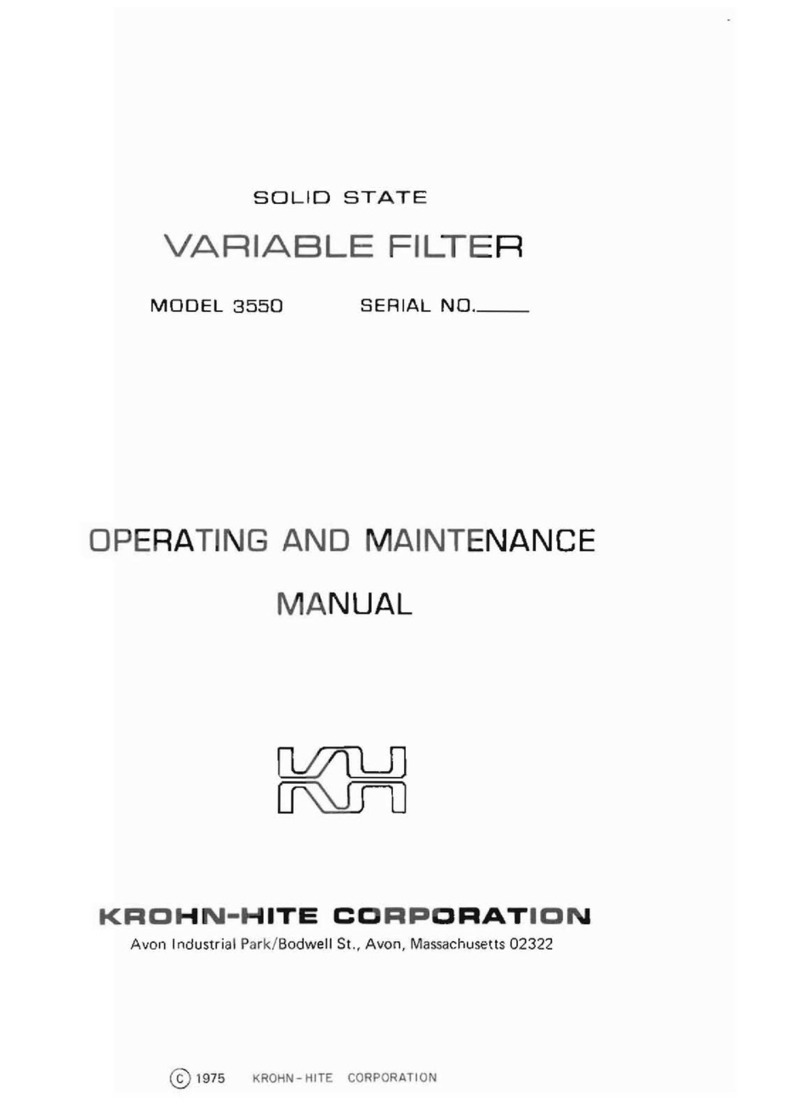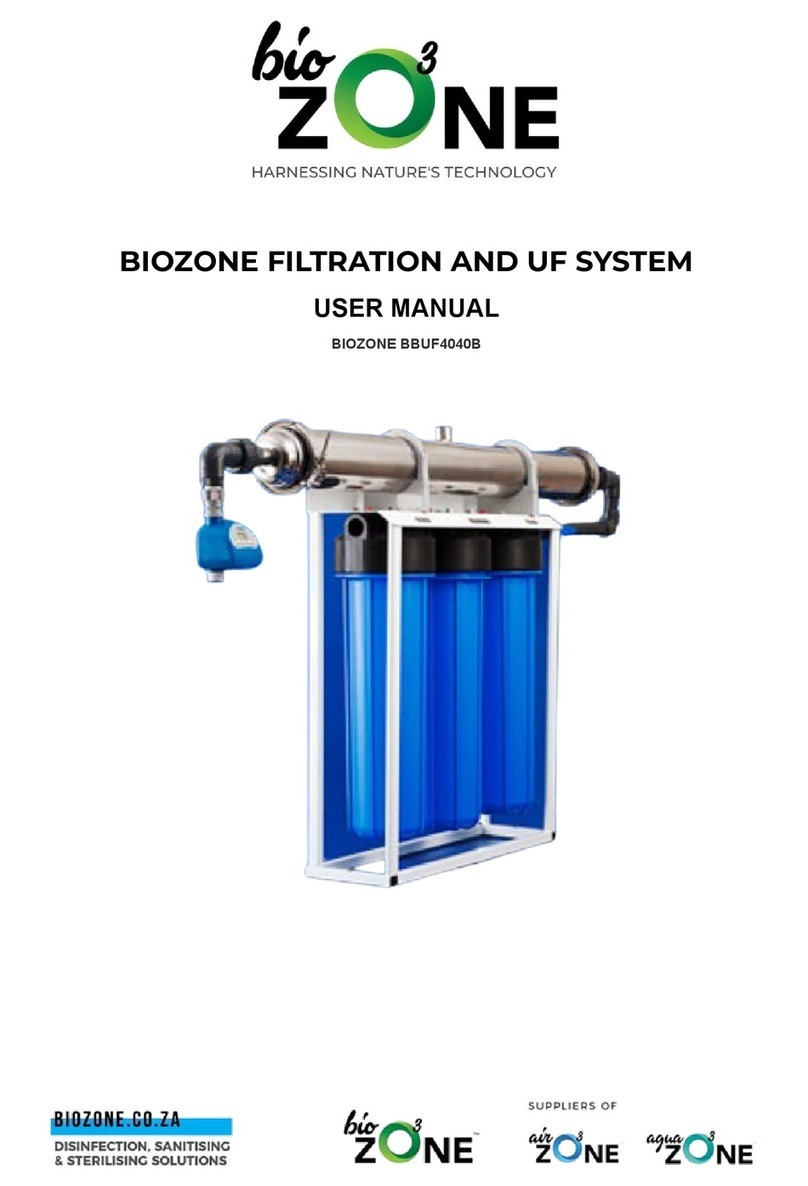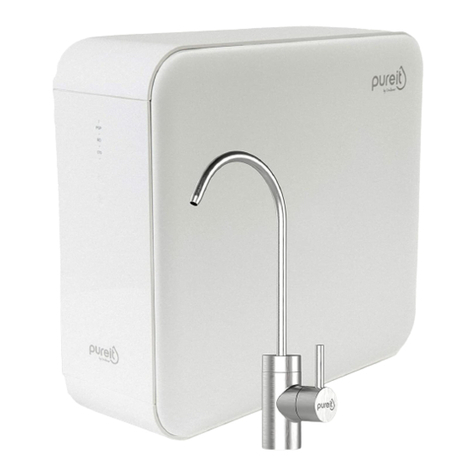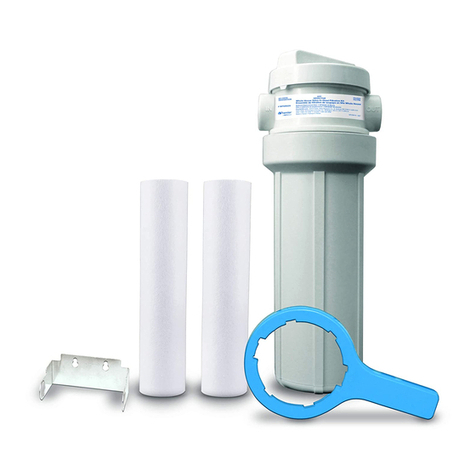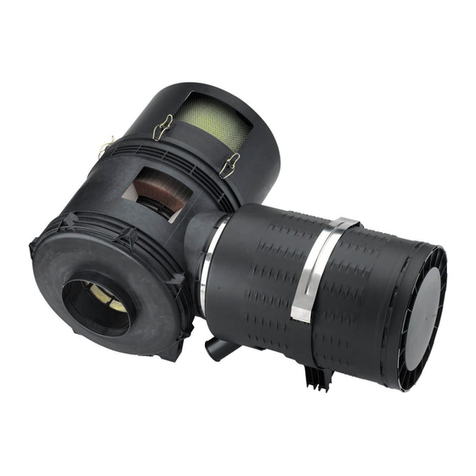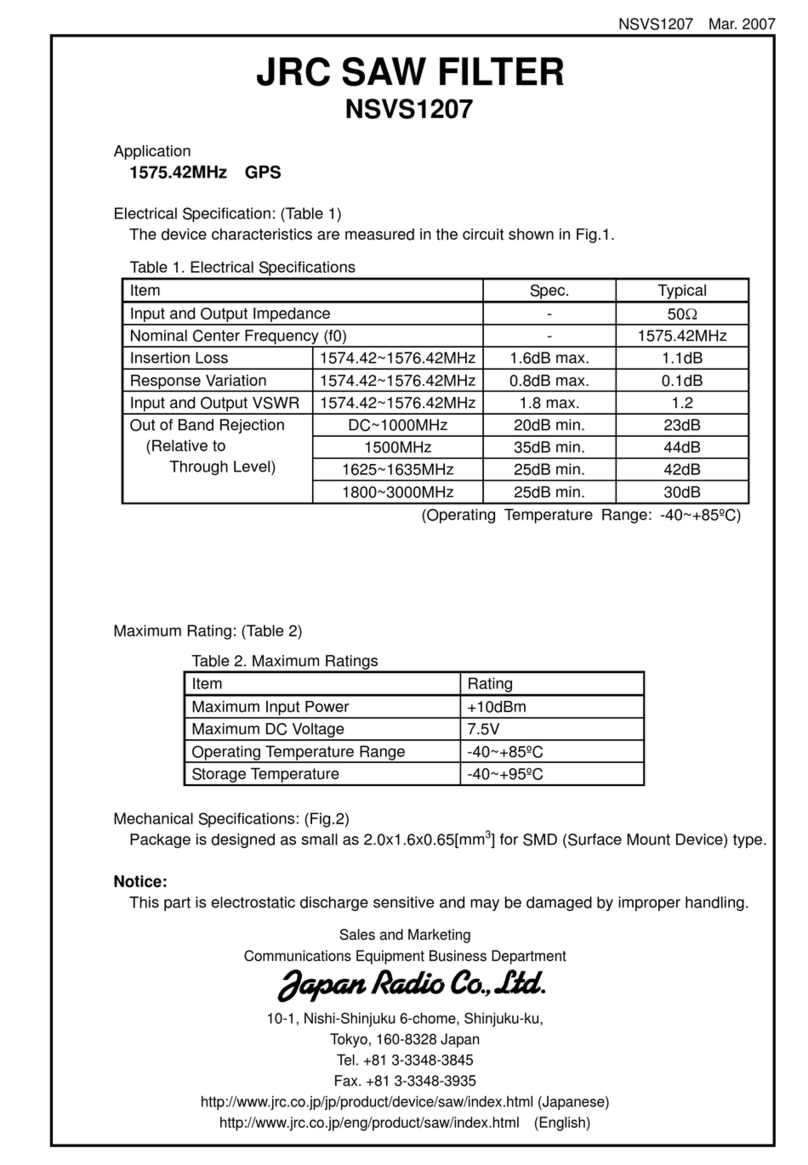Krohn-Hite 3380 Series User manual

Model 3380 Series
Tunable Active Filter
Operating Manual
0.1Hz to 200kHz
48dB/Octave Slope
Butterworth and Bessel Response
Low-Pass, High-Pass, Band-Pass, Band-Reject
Model 3381 - Single Channel
Model 3382 - Dual Channel
Model 3384 - Four Channel


Model 3380 Series
0.1Hz to 200kHz (0.005Hz Optional)
1, 2 or 4 Channels, 48dB/Octave Slope
Low-Pass/High-Pass, Butterworth/Bessel Filter
Operating
Manual
Copyright©2004 Krohn-Hite Corporation. All rights reserved. Contents of
this publication may not be reproduced in any form without the written
permission of Krohn-Hite Corporation. Printed in USA - 9/2004.
15 Jonathan Drive, Unit 4,
Brockton, MA 02301-5566 - Made in U.S.A.
Tel: (508) 580-1660; Fax: (508) 583-8989

Service and Warranty
Krohn-Hite Instruments are designed and manufactured in accordance with sound engineering practices and should give
long trouble-free service under normal operating conditions. If your instrument fails to provide satisfactory service and
you are unable to locate the source of trouble, contact our Service Department at (508) 580-1660, giving all the informa-
tion available concerning the failure.
DO NOT return the instrument without our written or verbal authorization to do so. After contacting us, we will issue a
Return Authorization Number which should be referenced on the packing slip and purchase order. In most cases, we will
be able to supply you with the information necessary to repair the instrument, avoiding any transportation problems and
costs. When it becomes necessary to return the instrument to the factory, kindly pack it carefully and ship it to us prepaid.
All Krohn-Hite products are warranted against defective materials and workmanship. This warranty applies for a period
of one year from the date of delivery to the Original Purchaser. Any instrument that is found within the one year warranty
period not to meet these standards, will be repaired or replaced. This warranty does not apply to electron tubes, fuses or
batteries. No other warranty is expressed or implied.
Krohn-Hite Corporation reserves the right to make design changes at any time without incurring any obligation to incor-
porate these changes in instruments previously purchased.
Modifications to this instrument must not be made without the written consent of an authorized employee of Krohn-Hite
Corporation.

Table of Contents
1.0 GENERAL DESCRIPTION ································1-1
1.1 INTRODUCTION ·········································1-1
1.2 SPECIFICATIONS ········································1-1
1.2.1 Functions (Each Channel) ·································1-1
1.2.2 Number of Channels · · · · · · · · · · · · · · · · · · · · · · · · · · · · · · · · · · · · 1-1
1.2.3 Filter Characteristics · · · · · · · · · · · · · · · · · · · · · · · · · · · · · · · · · · · · 1-1
1.2.4 General ···········································1-2
1.2.5 Options ···········································1-2
2.0 OPERATION········································2-1
2.1 INTRODUCTION ·········································2-1
2.2 TURN-ON PROCEDURE · · · · · · · · · · · · · · · · · · · · · · · · · · · · · · · · · · · · 2-1
2.3 SELF TEST············································2-1
2.4 OPERATION ···········································2-1
2.4.1 Front Panel Controls and Display ·····························2-1
2.4.1.1 Channel Selection (Models 3382 and 3384 only) ·················2-1
2.4.1.2 Setting Cutoff Frequency ·····························2-1
2.4.1.3 Digit Select/Frequency Increment and Decrement ················2-2
2.4.1.4 Setting Input Gain (Pre-Filter) ····························2-2
2.4.1.5 Setting Output Gain (Post Filter) ···························2-2
2.4.1.6 Butterworth/Bessel Selection [TYPE] ·······················2-2
2.4.1.7 Low-Pass and High-Pass Operation – [MODE] ··················2-2
2.4.1.8 Variable Band-Pass Operation (Models 3382 and 3384 only) ··········2-2
2.4.1.9 Variable Band-Reject Operation (Models 3382 and 3384 only)··········2-3
2.4.1.10 AC/DC Coupling ·································2-3
2.4.1.11 Differential/Single-Ended Input··························2-3
2.4.1.12 Storing a Filter Setup [STORE] · · · · · · · · · · · · · · · · · · · · · · · · · 2-3
2.4.1.13 Recalling a Filter Setup [RECLL]· · · · · · · · · · · · · · · · · · · · · · · · · 2-3
2.4.1.14 Clear Entry Key – [CE] · ·····························2-3
2.4.1.15 All Channel Mode (Models 3382 and 3384) – [ALL CH] ·············2-3
Model 3380 Series Table of Contents
i

Table of Contents
(Continued)
2.5 REAR PANEL DC LEVEL ADJUSTMENTS ···························2-3
2.5.1 DC Level Adj (Rear Panel) Out · · · · ··························2-3
2.5.2 DC Level Adj (Rear Panel) HP ·······························2-3
2.6 FILTER CHARACTERISTICS ··································2-4
2.6.1 Amplitude Response · · ··································2-4
2.6.2 Phase Response ······································2-4
2.6.3 Group Delay········································2-4
2.6.4 Transient Response · · ··································2-5
3.0 INCOMING ACCEPTANCE ································3-1
3.1 INTRODUCTION ·········································3-1
3.2 TEST EQUIPMENT REQUIRED ·································3-1
3.3 CUTOFF FREQUENCY ACCURACY · · · · ··························3-1
3.4 STOPBAND ATTENUATION···································3-1
3.5 PRE-FILTER AND POST-FILTER GAIN ACCURACY ·····················3-2
3.6 NOISE CHECK ··········································3-2
3.7 COMMON MODE REJECTION ·································3-2
3.8 DISTORTION AND MAXIMUM SIGNAL CHECKS ·······················3-2
3.9 AC/DC COUPLING CHECK ···································3-2
4.0 CALIBRATION ······································4-1
4.1 INTRODUCTION·········································4-1
4.2 REQUIRED TEST EQUIPMENT·································4-1
4.3 CALIBRATION··········································4-1
4.3.1 DC Level ··········································4-1
4.3.2 100kHz Differential Input Adjustment ···························4-2
4.3.3 Unity Gain ·········································4-2
4.3.4 High Band Frequency Calibration ·····························4-2
Table of Contents Model 3380 Series
ii

This page intentionally left blank.
Model 3380 Series Table of Contents
iii

Table of Contents Model 3380 Series
iv

SECTION 1
GENERAL DESCRIPTION
1.1 INTRODUCTION
The Krohn-Hite Model 3380 Filter Series (3381, 3382 and 3384) are one, two or four channel filters providing a tunable
frequency range from 0.1Hz to 200kHz; and with the 002 option, the range is extended to 0.005Hz. The frequency re-
sponse characteristic is selectable to either maximally flat (Butterworth) for clean filtering in the frequency domain, or
linear phase (Bessel) to provide superior filtering of pulse or complex signals.
Each channel of the 3380 Series is a selectable low-pass or high-pass, 8-pole filter providing an input gain of up to 50dB
and an output gain of up to 20dB, selectable in 0.1dB steps. The 3380 Series will accept input signals of ±10V peak at
0dB gain and has selectable ac or dc coupling. Memory is available for storing set-ups of the instrument which can be re-
called later with a simple command. The following pages are the specifications of the Model 3380 Series Filters.
1.2 SPECIFICATIONS
1.2.1 Functions (Each Channel)
Low-pass filter, high-pass filter; 2 or 4 channel models, one or two channel(s) of band-pass or band-reject via external
connections.
1.2.2 Number of Channels
Model Channels
3381 1
3382 2
3384 4
1.2.3 Filter Characteristics
Type: Selectable 8-pole Butterworth or 8-pole Bessel.
Attenuation: 48dB/octave.
Tunable Frequency Range fc: 0.1Hz to 200kHz; (option 002, 0.005Hz).
Frequency Resolution: 3 digits, ³1Hz fc; 0.001Hz, <1Hz fc.
Cutoff Frequency Accuracy: ±3%.
Relative Gain at fc: –3.01dB, Butterworth; –12.59dB, Bessel.
Model 3380 Series Section 1 - General Description
1-1

Passband Gain: ±0.2dB.
High-Pass Bandwidth (0dB Gain): >2MHz.
Stopband Attenuation: >100dB.
Maximum Input: ±10V peak at 0dB gain, reduced in proportion to gain setting.
Pre-Filter Gain: 0dB, 10dB, 20dB, 30dB, 40dB, 50dB, ±0.2dB.
Post-Filter Gain: 0dB to 20dB selectable in 0.1dB
steps, ±0.2dB.
Wideband Noise (2MHz bandwidth detector): 0dB gain, <400µVrms; Max input gain, <5µVrms RTI;
Max. gain <25µVrms RTI.
Harmonic Distortion (1V output): –60dB (0.1%) to 10kHz; –50dB (0.3%) to 200kHz..
Input: Differential or single-ended.
CMRR: >60dB to 10kHz; >50dB to 100kHz.
Sensitivity: 3mV peak with 70dB total gain for 10V peak output.
Impedance: 1 megohm in parallel with 25pf.
Coupling: ac (0.16Hz) or dc.
Maximum DC Component: ±100V in ac coupled mode.
Output:
Maximum Voltage (open circuit): ±10V peak.
Maximum Current: ±80mA peak.
Impedance: 50 ohms.
DC Offset: Adjustable to zero volts.
1.2.4 General
Crosstalk Between Channels: –80dB for fsig £200kHz, –70dB for fsig >200kHz with input source £50 ohms.
Memory: 9 stored set-ups (0 - 8).
Self-Test Diagnostics: MPU checks unit upon power-up. Display indicates failure mode.
Displays: 7 segment, green, LED; 0.3" high.
Operating Temperature: 0°C to 50°C.
Isolation to Chassis: ±200Vdc.
Input/Output Connectors: BNC.
Power: 3381, 9 watts; 3382, 16 watts; 3384, 30 watts.
Dimensions and Weights: 312“ (9cm) high, 14" (35.56cm) wide, 1212” (31.75cm) deep; 7 lbs (3.18kg) net, 9 lbs (4.09kg)
shipping.
1.2.5 Options
002: extends low end cutoff to 0.005Hz.
BK-330: Battery Option, up to 8 hours of operation, rechargable NiCad batteries (factory installation).
Section 1 - General Description Model 3380 Series
1-2

Rack Mount Kit: Part No. RK-314, permits installation of the Model 3380 Series into a standard 19" rack spacing.
Extended 1 Year Warranty: Part No. EX3380.
Specifications apply at 25°C, ±5°C.
Model 3380 Series Section 1 - General Description
1-3

This page intentionally left blank.
Section 1 - General Description Model 3380 Series
1-4

SECTION 2
OPERATION
2.1 INTRODUCTION
The Model 3381, 3382 and 3384 Filters are one, two or four channel filters respectively, providing a tunable frequency
range of 0.1Hz to 200kHz (0.005Hz with option 002).
Each channel is selectable low-pass or high-pass, 8-pole with input gain from 0dB to 50dB, selectable in 10dB steps; and
output gain from 0dB to 20dB, selectable in 0.1dB steps.
The input signal can be ±10V peak at 0dB gain and has selectable ac or dc coupling. Memory is available for storing
set-ups of the front panel settings which can be recalled later with a keystroke entry.
Each mode of operation will be explained in this section.
2.2 TURN-ON PROCEDURE
The Model 3380 line voltage range has been preset for either 115V or 230V, Norm, line voltage. When making any
changes to the line connections, remove the power cord.
To change the Norm/Low line setting, remove the top cover to expose the Norm/Low line switch located near the rear
panel, under the back shield.
To achieve access to the 120V/240V connections, remove the bottom cover and change the connections to the desired
voltage as shown in Figure
2.1.
Model 3380 Series Section 2 - Operation
2-1
Figure 2.1 Jumper Settings for 120V/240V Operation
120V 240V
Bottom View

Note: On early models, a 120V/240V switch was provided next to the Norm/Low line switch.
120V
240V
Jumper
Norm
Low
Line Switch
Input
Voltage
Range
(rms)
Install Fuse
Model 3381 Model 3382 Model 3384
120V Norm 108-132 .15A 1/4A 1/2A
Low 90-110
240V Norm 216-264 .1A 1/8A 1/4A
Low 180-220
Power Consumption
(watts)
120V/240V
Jumper
Model
3381
Model
3382
Model
3384
120V 81426
91630
240V 81426
91630
Set the 120V/240V and Norm/Low line switch and jumpers as needed according to the table above.
Be sure to change the fuse to the proper rating for the line switch setting selected. Replace the cover.
Plug the line cord into the unit, then the ac outlet.
After reading the Self-Test feature, described next, turn on the Model 3380.
Section 2 - Operation Model 3380 Series
2-2
Model 3382 Filters

2.3 SELF TEST
When the Model 3380 is turned on, the microprocessor performs a self-test routine whereby the entire RAM and ROM
operation is verified. If there is a malfunction, such as a defective RAM or ROM, the word “bad” will appear in the DIS-
PLAY followed by a number 1 or 2. “bad 1” indicates U16, microprocessor is defective and a “bad 2” indicates U17,
EPROM is defective.
When the self-test program has completed, the Model 3380 will return to the setup stored in storage location 0. The
Model 3380 is now ready for operation.
2.4 OPERATION
2.4.1 Front Panel Controls and Display
2.4.1.1 Channel Selection (Models 3382 and 3384 only)
The up [Δ] control key below the CHANNEL display increments the channel number. The various displays and indica-
tors on the front panel (cutoff frequency, gains, etc.) pertain to the channel indicated by this display.
2.4.1.2 Setting Cutoff Frequency
Data entry keys [0] to [9], [.], [KILO] and [MEGA] set the numeric value of the cutoff frequency desired. To select
1.5kHz, press the [1][.][5] data keys and parameter keys [KILO] and [FREQ]. The cutoff frequency for the channel se-
lected will be indicated in Hertz on the four digit DISPLAY (when [ALL CH] mode is selected, the frequency will be
changed on all channels). The KILO and FREQ keys will be lit.
2.4.1.3 Digit Select/Frequency Increment and Decrement
When the [SHIFT] key is pressed, followed by the DIGIT SELECT [Δ] or [∇] keys, the FREQUENCY DISPLAY will
intensify a digit. Pressing the [SHIFT] followed by the [Δ] or [∇] key again, will intensify the next digit or will turn the
DIGIT SELECT off. The [Δ] will move the intensified digit to the left and the [∇] will move the intensified digit to the
right (direction is labeled in red to the left of keys).
Pressing the [Δ] or [∇] keys will then increment or decrement the intensified frequency digit.
2.4.1.4 Setting Input Gain (Pre-Filter)
Up [Δ] and down [∇] INPUT GAIN SET controls increase or decrease the input amplifier by 10dB. The two digit DIS-
PLAY will indicate either 0dB, 10dB 20dB, 30dB, 40dB or 50dB. May also be set by entering gain desired directly on
the keypad and pressing either the [Δ] or [∇] gain key.
2.4.1.5 Setting Output Gain (Post Filter)
Up [Δ] and down [∇] OUTPUT GAIN SET controls increase or decrease the output amplifier by 0.1dB steps from 0dB
to 20.0dB. For gains <10dB, 0.1dB resolution is displayed. For gains >10dB, only 1dB resolution is displayed; however,
the up [Δ] and down [∇] keys continue to increment and decrement the gain by 0.1dB. The full 3-digit resolution may be
seen in the middle display by pressing [SHIFT] the [Δ] or [∇] key under the output gain display. Also for gains >10dB,
the decimal point is off for whole dB’s (10, 11, 12, etc.) but on for fractional (10.1 – 10.9, 11.1 – 11.9, etc.). Gain may
also be set by entering gain desired directly on the keypad and pressing either the [Δ] or [∇] gain key.
2.4.1.6 Butterworth or Bessel Selection – [TYPE]
When [TYPE] is pressed once, DISPLAY indicates the present filter type, “bu.” (Butterworth) and “bES.” (Bessel).
When pressed again, the type will change (i.e. if the type was “bES.” , the change will be to “bu.”.)
Model 3380 Series Section 2 - Operation
2-3

2.4.1.7 Low-Pass and High-Pass Operation – [MODE]
When [MODE] is pressed once, DISPLAY indicates the present filter type, “h.P.” (high-pass) and “L.P.” (low-pass).
When pressed again, the type will change (if the type was “L.P.” , the change will be to “h.P.”).
2.4.1.8 Variable Band-Pass Operation (Models 3382 and 3384 only)
To obtain Band-Pass operation with 48dB per octave attenuation proceed as follows:
Set channel 1 to high-pass mode (this will control the low cutoff frequency). Set channel 2 to low-pass (this will control
the high cutoff frequency). Connect the input signal to channel 1 input, connect the channel 1 output to the channel 2 in-
put and connect the load to the channel 2 output. For the Model 3384, the same can be done with channels 3 and 4 respec-
tively.
The minimum pass-band is obtained by setting the high cutoff frequency equal to the low cutoff frequency. In this condi-
tion the insertion loss is nominally 6dB (in the Butterworth mode) and the –3dB cutoff frequencies occur at 0.8 and 1.25
times the mid-band frequency. Insertion loss may be made-up by setting output gains to +6dB.
2.4.1.9 Variable Band-Reject Operation (Models 3382 and 3384 only)
To obtain Band-Reject or Notch operation, proceed as follows:
Connect the two channels in parallel by connecting the input signal to the input of each channel simultaneously. The out-
put from both channels should be added through two equal external resistors in series with each output. The junction of
these resistors becomes the output of the filter. It is recommended that the resistors be approximately 1k ohms and of the
carbon or metal film type if the filter is used at higher frequencies. If the two resistors are not equal, the gain on one side
of the notch will be different than the gain of the other. Insertion loss may be made-up by setting output gains to +6dB.
Set channel 1 for low-pass and channel 2 for high-pass, and adjust the cutoff of each channel for the maximum rejection.
The ideal notch occurs when setting the low cutoff (low-pass) to 0.5 and the high cutoff (high-pass) to 1.5 notch. Inser-
tion loss may be made-up by setting output gains to +6dB.
Caution: Do not exceed specified voltage at terminals.
2.4.1.10 AC/DC Coupling
Pressing the [SHIFT] key, followed by the [TYPE] key, will display the present input coupling, indicating “AC” or
“dC”. Press [SHIFT] [TYPE] again to toggle between AC and DC.
2.4.1.11 Differential/Single-Ended Input
LED indicators are provided on the front panel to indicate which input(s) is (are) active. Pressing [SHIFT] and then the
[+ONLY] key under the Input Gain Display will select single-ended input mode, only the LED beside the +Input of the
selected channel will be lit. Pressing [SHIFT] and then the [DIFF] key, will select the differential input mode and both
LEDs beside the selected channel will be lit.
2.4.1.12 Storing a Filter Setup – [STORE]
There are 9 storage locations for storing front panel filter setups. The locations are numbered 0 through 8. When
[SHIFT] [RECLL][STORE] is first pressed, the DISPLAY indicates the number of the next memory location available.
For example, the DISPLAY will indicate the following: “n=05”. Pressing [RECLL] again will store the entire filter
set-up into that memory location. If another memory location is desired, enter that location on the keyboard and then
press [SHIFT] [RECLL].When [SHIFT] [RECLL] is preceded by a number (0-8), the 3380 will store the current filter
set-up into the memory location selected.
When [SHIFT] [RECLL] is pressed to indicate the next memory location only, pressing the clear entry key [CE] will re-
store the DISPLAY to the cutoff frequency setting. The filter settings stored in memory location 0 is automatically re-
called at turn-on.
Section 2 - Operation Model 3380 Series
2-4

2.4.1.13 Recalling a Filter Setup – [RECLL]
When [RECLL] is preceded by a number, it will recall the filter set-up which was stored in the memory location selected.
Selectable locations are 0 to 8.
When first pressed, the DISPLAY indicates the number of the memory location to be recalled. For example, the DIS-
PLAY will indicate the following: “n=05”. Pressing the [RCLL] key again will recall the entire filter set-up from mem-
ory location “05”.
When pressed to indicate the memory location to be recalled only, pressing the [CE] (clear entry key) will restore the
DISPLAY to the cutoff frequency setting.
Memory location 0 is automatically recalled at turn-on.
2.4.1.14 Clear Entry Key – [CE]
When entering a numeric value in the keyboard, but not specifying a parameter, pressing the clear entry key will restore
the DISPLAY to the current cutoff frequency setting.
When a numeric value and its parameter has been entered and the numeric value is then changed, pressing the [CE] key
will restore DISPLAY to the previous value of that parameter. Pressing the [CE] key continuously will toggle between
the previous keypad entry and the present entry.
When either the [STORE] or [RECALL] key is pressed, the next memory location will be indicated on the DISPLAY.
Pressing the [CE] key will restore DISPLAY to the current cutoff frequency setting.
2.4.1.15 All Channel Mode – [ALL CH] (Models 3382 and 3384)
When [ALL CH] is pressed, the LED in the [ALL CH] key will light; and when frequency, input/output gain, type, mode,
+only or diff input, and/or coupling is entered or changed, the new setting will be entered in all channels of the filter.
2.5 REAR PANEL DC LEVEL ADJ.
The Model 3380 rear panel has 2, 4 or 8 output dc level adjustments. The following procedure is for adjusting the output
dc level to zero volts for any channel.
2.5.1 DC Level Adj. (Rear Panel) HP
Set the filter to HP at 1.1kHz. Adjust HP for 0V at filter output.
2.5.2 DC Level Adj (Rear Panel) Out
At any frequency setting, the output dc level may be adjusted to zero volts for each channel with the rear panel, screw-
driver adjust, output dc level control.
Model 3380 Series Section 2 - Operation
2-5

2.6 FILTER CHARACTERISTICS
2.6.1 Amplitude Response
Each channel of the Model 3380 can operate in either the low-pass or high-pass mode at 48dB/octave attenuation and
provide either maximally flat (Butterworth) amplitude response or linear phase (Bessel) operation. Comparative ampli-
tude response characteristics in both modes are shown in Figure 2.2A and 2.2B.
2.6.2 Phase Response
Phase characteristics of the Model 3380 is shown in Figure 2.3. The graph of the filter response provides output phase
relative to the input over a 10:1 frequency range.
Section 2 - Operation Model 3380 Series
2-6
Figure 2.2B High-Pass Amplitude Response
Figure 2.2A Low-Pass Amplitude Response

2.6.3 Group Delay
Group delay1, shown in Figure 2.4, on opposite page, is defined as the derivative of radian phase with respect to radian
frequency, which is the slope of the phase curve. A flat group delay is considered a linear phase response which corre-
sponds to a constant slope of the phase curve. With linear phase response, the distortion of complex data signals will be
minimized because their various frequency components, due to constant time delay, will not shift relative phase.
In numeric terms, the zero frequency phase slope is –293.7°/Hz for Butterworth and –351.9°/Hz for Bessel, when normal-
ized for a cutoff frequency of 1Hz. This will be 2πtimes greater in °/Hz for a cutoff of 1 radian/sec or –1845°/Hz and
–2211°/Hz respectively. Dividing by 360 converts °/Hz to radians/radians-per-sec yields a group delay time of 5.13s for
Butterworth and 6.14s for Bessel.
Model 3380 Series Section 2 - Operation
2-7
Figure 2.3 Phase Response
[1] IEEE Standard Dictionary of Electrical and Electronic Terms, Institute of Electrical and Electronic Engineers,
IEEE-STD 100-1977, Second Edition, 1977, page 296. , shown in Figur , shown in Figur

2.6.4 Transient Response
The normalized response for a unit step voltage applied to the input of the Model 3380 operating in the low-pass mode
with both Butterworth and Bessel response is shown in Figure 2.5, on page 2-12.
Section 2 - Operation Model 3380 Series
2-8
Figure 2.4 Group Delay
This manual suits for next models
3
Table of contents
Other Krohn-Hite Water Filtration System manuals
Popular Water Filtration System manuals by other brands
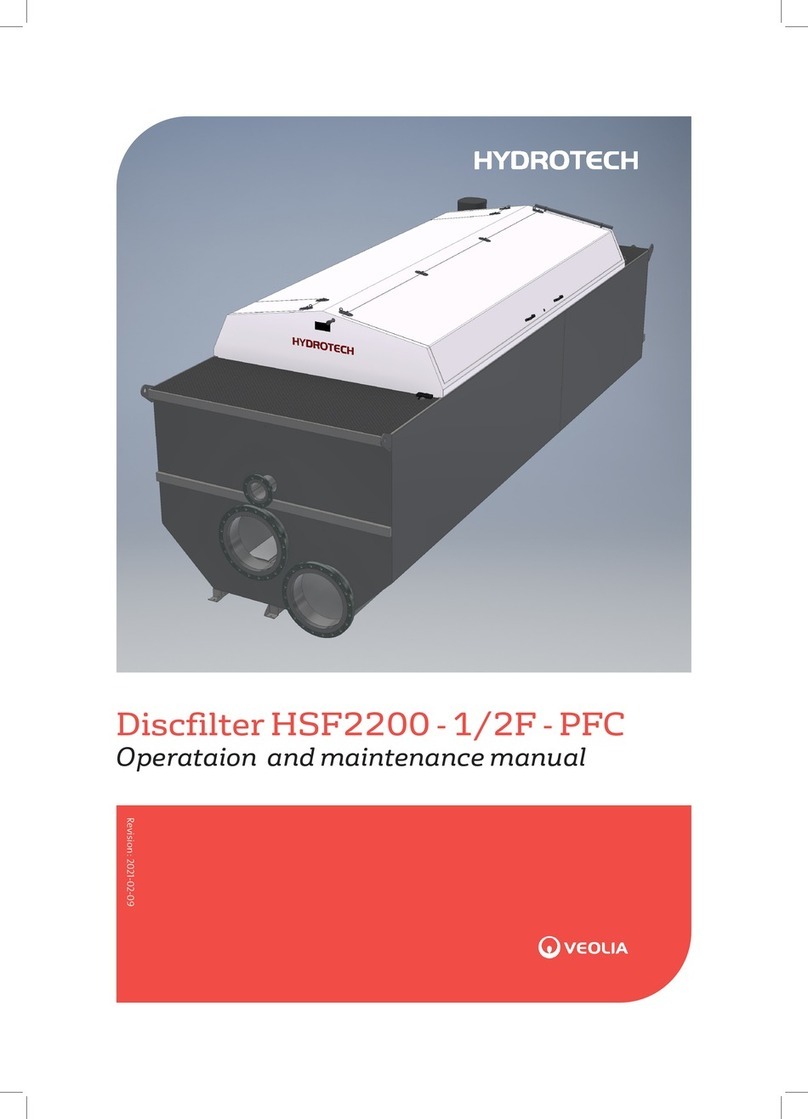
Veolia
Veolia HYDROTECH HSF2200-1F-PFC Operation and maintenance manual
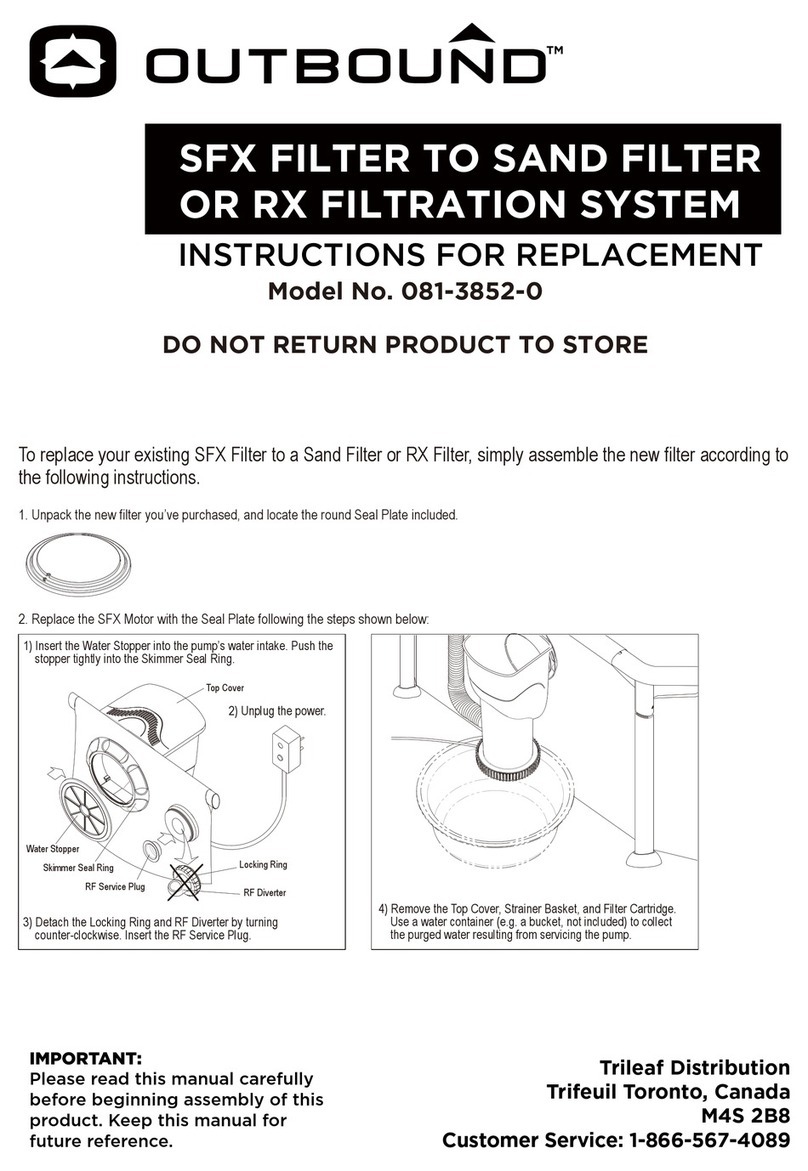
Outbound
Outbound 081-3852-0 Installation Instructions for Replacement

Doulton
Doulton EcoFast installation instructions
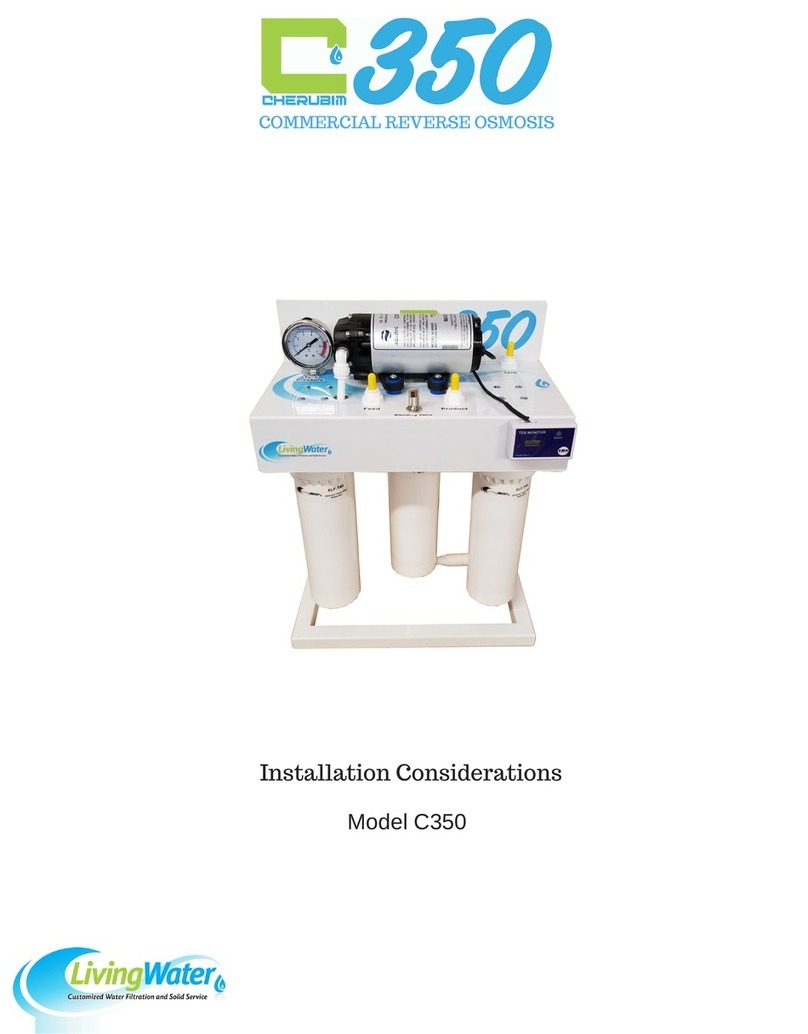
Living Water
Living Water C350 Installation Considerations
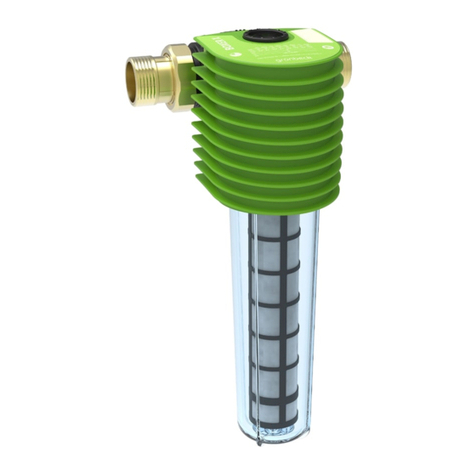
Grunbeck
Grunbeck BOXER KX Operation manual
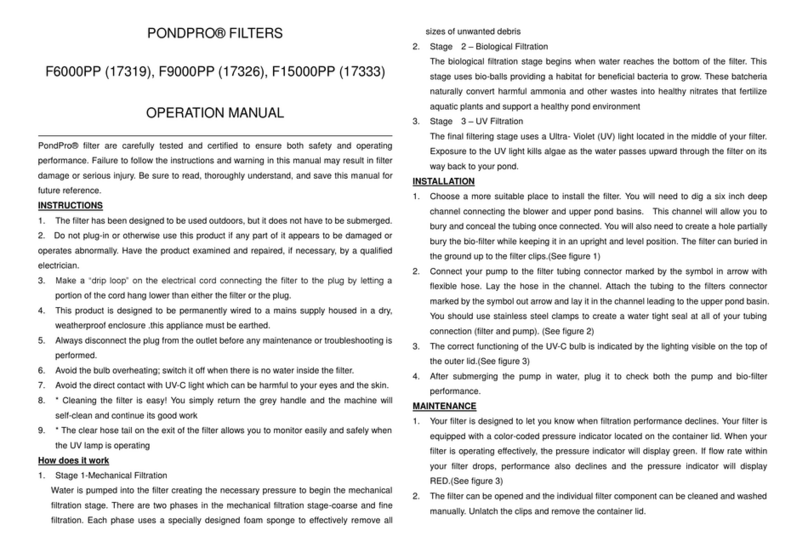
ASCENTO
ASCENTO PONDPRO F6000PP Operation manual

